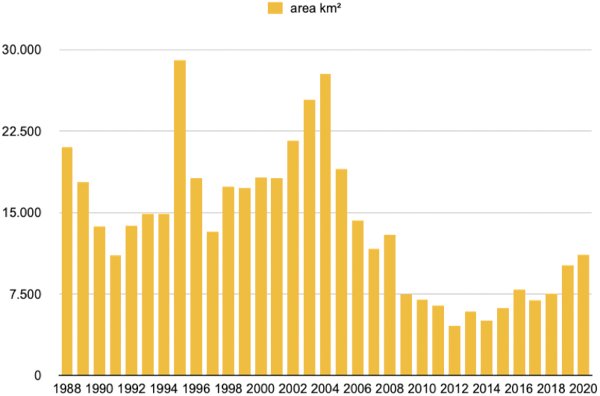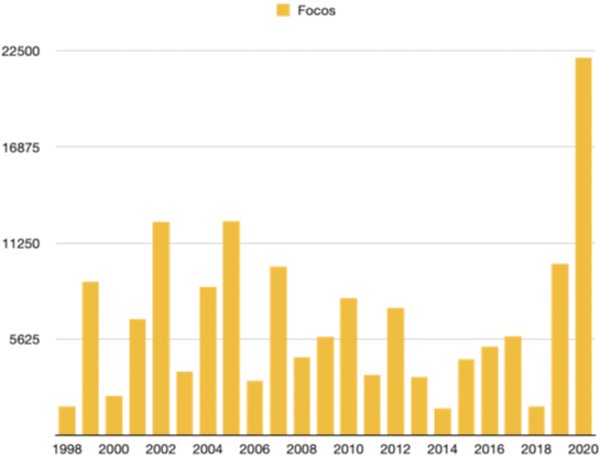Our key messages
1) The intensification of both deforestation and forest fires in the last two years must be understood as a common challenge in the defense of the Amazon, Cerrado, and Pantanal.
Yearly deforestation in the Legal Amazon

The “Day of Fire” in August 2019, along the BR-163 and Transamazon highways – when rural producers orchestrated a joint attack with fire against the forest – was the most dramatic expression of processes that have made the states of Pará and Mato Grosso champions in cumulative deforestation for the region, with 34.46% and 32.34%, respectively. The historic arc of deforestation on the southern and eastern borders of the Amazon, following the expansion of the agricultural frontier, has penetrated into the heart of the forest along highways through the deforestation and land grabbing by agents who feel certain of the impunity of their actions. Other criminal activities that degrade the forest, such as logging – mostly performed with slave labor – and illegal gold mining (garimpo), especially on indigenous lands and conservation units, have also expanded in this same context.
The Cerrado has been undergoing unprecedented and intense deforestation for more than four decades, devastating more than half of the Brazilian savannah and foreshadowing its possible extinction in the next few years, if nothing is done to contain it. The transition area into the Amazon is the rainforest’s historical arc of deforestation, where the agricultural frontier is pushing to expand beyond the Cerrado. It is also the region with the highest intensity of rural conflicts in the country (data from the Pastoral Land Commission / CPT). On the eastern side of the region, in the Matopiba agricultural frontier, the Cerrado has been deforested more in the past 20 years (12.23 million hectares from 2000 to 2019) than in the previous 500 years (10.75 million hectares until 2000), according to data from the INPE’s PRODES Cerrado. The municipalities with the highest deforestation growth rates in the Cerrado are mainly located in the Matopiba soybean frontier.
Cumulative deforestation on the rise in the Cerrado - by municipality

Fire outbreaks in the Pantanal

2) Agribusiness' responsibility: Fire as a tool to consolidate land grabbing.
Land grabbers take advantage of the government’s leniency to set fire to the Pantanal, the Cerrado and the Amazon. Destroying the vegetation on public lands, most of which are undesignated and occupied by traditional communities, helps them consolidate the process of land grabbing. To begin with, they know they will be able to legalize titles to the illegally appropriated land, with the collusion of Notary Publics’ Offices, and can feel sure of a future amnesty for the illegal deforestation, even in areas of mandatory legal reserve on regularized rural properties. It is a historical cycle of deforestation, fire, land grabbing, and amnesty, based on the certainty of impunity, reinforced by a government that dismantles its own enforcement and control agencies and arms the rural landowning classes to wreak violence and conflicts in the countryside.
The Brazilian State uses various means to institutionalize land grabbing. Greater flexibilities adopted in the last decade for granting land and environmental regularizations, no oversight of rural property registries and collusion inside the court system with illegal takeovers of traditional territories, all directly foster more deforestation and undermine the livelihoods of peoples in the Pantanal, Cerrado, and Amazon. Concretely, bill 2,633/2020, known as the “land grabbing bill”, now going through Congress, is a promise of amnesty in the works for land grabbers.
Although the boundaries between legal and illegal deforestation are blurred, precisely because of the history of amnesties and regularizations of crimes, studies show that 62% of strictly illegal deforestation in the Cerrado and Amazon (in terms of clear-cut hectares), between 2008 and 2019, was concentrated in 2% of the farms in these regions. The Pantanal is emblematic of this dynamic: most of the destruction of the Mato Grosso Pantanal by fires in 2020 (480,000 ha) occurred during the state’s fire ban period, which began on July 1, 2020. About 67.5% of the total (324,000 ha) caught fire from nine initial outbreaks, five of which were on farms registered in the Rural Environmental Registry (CAR) as private rural properties. The owners of these specific farms sell cattle to the Ammagi and Bom Futuro groups, which in turn supply beef to conglomerates such as JBS, Marfrig, and Minerva. Those outbreaks alone caused fires that burned approximately 117,000 hectares in the Pantanal (an area the size of the city of Rio de Janeiro). Another three fires set in unregistered areas burned another 148,000 hectares. The landgrabbing-fires-deforestation triad is the trademark of the Bolsonaro government.
Deforested areas are used to produce agricultural commodities – not food – mostly for export, bearing the blood of people and the devastation of territories. While the government sacrifices forests to enable the takeover of public lands and export commodities, food security has receded in Brazil to levels worse than 2004, when it was first measured by the IBGE.
3) The Bolsonaro government colludes with devastation by both act and omission.
The increase in deforestation and forest fires reflects the dismantling and militarization of environmental agencies and the relaxation of deforestation enforcement policies. Let us not forget that at a banquet with American conservatives early in his administration, in March 2019, Jair Bolsonaro shamelessly asserted that “Brazil is not an open field where we intend to build things for our people. We have to take down a lot of things. Undo a lot of things. So that afterwards we can start over.” It was in this same vein that a year later, in April 2020, Minister Ricardo Salles laid out his infamous strategy of taking advantage of the media’s focus on the pandemic, to change all the environmental rules and regulations and “let the herd go through”.
Part of the dismantling process has been to cut back the budget of the Ministry of Environment (MMA), which has all but vanished. Despite the peak in deforestation and forest fires, the government submitted the lowest budget in 21 years for the ministry this year. The 2021 Annual Budget Bill (PLOA) (PL 28/2020) sent to Congress by Bolsonaro provides R$ 1.72 billion for the ministry, with 88% of its discretionary spending allocated to routine administrative expenses, such as rent and outsourced services. With this budget, the MMA will be allowed to spend only R$ 4.6 million on its core activities. This in practice means shutting the ministry down, without the burden of formally dissolving it, as Bolsonaro had promised during his 2018 presidential campaign.
The Chico Mendes Institute for Conservation and Biodiversity (ICMBio) and the Brazilian Institute for the Environment and Renewable Natural Resources (Ibama) have also suffered from the constant restructuring of the ministry on which they depend, through both budget cutbacks and the appointment to strategic positions of military personnel with no technical expertise in environmental enforcement operations, leading to disastrous results.
The government’s dismantling and demoralization of the National Institute for Space Research (INPE) also contribute to more environmental devastation. Since July 2019, when it disclosed an 88% upsurge in deforestation in the Legal Amazon region, compared to the same month in 2018, the INPE has been targeted by the Bolsonaro government. Not only does the government refuse to acknowledge the march of deforestation, its positions are offensive and harmful to scientific knowledge, by discrediting serious research in Brazil.
The Bolsonaro government has also dismantled public institutions such as the National Indian Foundation (Funai) and the National Institute for Settlements and Agrarian Reform (Incra), paralyzing land demarcation processes. Together with the rural caucus in the National Congress, it has pushed for new laws that favor land grabbing and legalize deforestation.
These acts and omissions are neither occasional nor isolated, but rather converge to put Brazil at the service of agribusiness, benefiting the rural caucus of landowners and land grabbers in the National Congress, while promoting deforestation and attacks on the territorial rights of indigenous peoples and traditional communities.
4) The use of fire in traditional farming systems is ancestral knowledge, in stark contrast to criminal fires set by agribusiness.
In various forest, grassland, wetland, and savannah ecosystems, there are management traditions that use fire to help fertilize the soil for new crops (such as slash-and-burn, coivara, or shifting cultivation), to manage native grasslands for livestock, and/or to regrow certain species for the collection of forest products. It is part of a process that builds agrobiodiversity over time, that is, the conscious cultivation of a combination of diverse plant species to be used by humans, whether as food, for animal husbandry, handicrafts, architecture, medicine, or rituals.
In traditional systems, this managed fire – whether in the Cerrado, the Pantanal, or the Amazon – abides by customary rules that respect the right time and place (small areas and rotating use) and the method to set the fire, to keep it from spreading. To protect their standing forests, peoples and communities are careful with this process and establish collective protocols.
Criminal fires, on the other hand, are set for destruction, to tighten the grip on land that has been grabbed. They are set during the dry season from several different starting points, often laying rows of trees and branches in areas prepared for the fire to spread. Surveys of fires on privately-owned land in the Pantanal clearly reveal this criminal behavior that the Bolsonaro government wants to cover up by blaming and criminalizing traditional systems instead!
5) When the Pantanal, the Cerrado, and the Amazon catch fire, it is the peoples’ and communities’ ways of life that go up in flames.
We can never forget that beneath the numbers, the photographs of devastation, and the satellite images of fires, there are conflicts over land, and biodiversity is being destroyed, along with indigenous and traditional ways of life.
The ways of life of indigenous peoples and of quilombola, traditional and agrarian reform communities are intertwined with the forests on which they depend for pure and abundant water, for clean air, for food, to generate income by selling their products at markets, to gather their traditional medicines, and to maintain their cultural and spiritual traditions.
That is why when the Pantanal, the Cerrado and the Amazon catch fire, it is these ways of life that go up in flames. Their social reproduction is jeopardized and the material basis for their very existence usurped.
The air polluted by the smoke of deforestation when it reaches big cities and the terrifying images of scorched wildlife dying should outrage and mobilize us to fight for political change. But when we see images of devastation, we must also imagine the peoples and the communities holding legacies of traditional knowledge that guides their management and conservation of water and biodiversity. They are the guardians and defenders of these commons!
